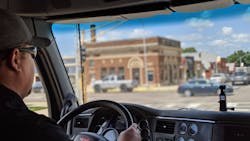With repair costs, insurance rate hikes, and nuclear verdicts, no carrier wants to deal with a collision. Some fleets have implemented programs to incentivize drivers who drive safely. Experts recently spoke to trucking stakeholders to offer tips on implementing driver incentives into a fleet's safety program.
"I don't really think that the general motoring public has really caught on that there's thousands of fleets that have cameras," Jeff Lisowski, general manager of Lamb Fuels, told an online audience. "These days of having these kinds of accidents and getting away with it when that that person is in the wrong, I don't think that people realize those days are coming to a close."
1. Develop and share safety goals
Carriers often start with broad goals, but to be effective, those goals should be tied to specific, measurable actions of the drivers.
"At the beginning of it, you might think that your goal is to reduce collisions—and that's a great goal," said Adam Lang, Netradyne's director of customer advisory services. "But as you start talking about that goal, maybe it evolves into something else that winds up with you getting very specific, reducing specific types of behaviors that could lead to a collision."
For example, a fleet focused on the broad goal of improving driver safety compliance can tell its drivers it wants to reduce harsh braking, follow speed limits, and limit phone usage. All of these data points can be easily measured.
Goals should be discussed in group settings to ensure that drivers, dispatchers, and safety personnel are on the same page. Managers can re-evaluate goals as driver data streams in, then communicate any changes during regular meetings.
"Be very specific on what goals you are going to do, and then share it with everyone and develop a cadence," Lang said. "'We're going to communicate these goals on a weekly basis to let everyone know if we're if we're winning or losing.' I mean, everyone wants to win, right?"
Lang added that managers should ensure their goals are SMART—specific, measurable, achievable, relevant, and time-bound. Ensuring that goals contain these elements improves the chances of success, he said.
2. Ask for driver feedback
Once management determines goals and conveys those to drivers, they should get feedback from the drivers to ensure that the goals make sense and are realistic.
"It's important to work with your team to come up with joint goals," said Adam Kahn, chief business development officer at Netradyne. "People like to be taught and not told."
"There are many times where a driver might come and talk to me about an issue, and I can't visualize it in my head," Lang said, "so I would walk outside with the driver to the equipment or to whatever the pain point was, and I would try to see exactly what they were talking about.
Lang advocates for driver advisory boards, describing himself as a "big fan" of the initiative. A running group of drivers to speak with can become a barometer of fleet culture. By regularly communicating with the advisory board, carriers may be able to develop grassroots-led goals.
He gave the example of a carrier that wants to reduce cell phone violations. The drivers might be confused about why that is, as dispatch constantly calls drivers on their cell phones. That could indicate that management should rethink how and when to communicate with drivers.
3. Gamification
Gamifying safety can be a powerful motivating tool. Netradyne offers GreenZone, a driver scoring platform that doesn't merely focus on negative events but also on positive driving that can increase a driver's score. Many fleet customers reward their safest drivers for reaching certain score thresholds on the platform.
"We use a monetary incentivization," Lisowski said, saying that extra payment is more effective than company-branded merchandise. "Swag is nice. It's good to have. I like it. But you know, for us, San Diego is now one of the most expensive places to live in the country.
According to Kahn, for every 50-point increase in GreenZone scoring, there is an approximate 12% reduction in accidents per million miles. Fewer accidents lead to cost savings that can be used to fund driver programs.
The average cost of replacing a driver is at least $12,000, according to Lang.
"Incentivizing them is so, so important," Lang said. "We've got to give them skin in the game. We've got to show them that their efforts matter," adding that recognizing drivers who reach goals is a non-monetary way to do that, to tell the driver, "Hey, you're a member of this team. You helped us reach this Green Zone score, or you helped us reduce the frequency and severity on our claims. It's because of you that we won. You matter."
"That's really powerful stuff that will improve your fleet culture."
4. Recognize and share success
Incentivizing drivers through payment or other means is a way to recognize their safe, quality work. However, sharing examples of success, whether in a regular meeting or a company newsletter, can also encourage drivers to operate more safely.
"Envy is a stronger tool than punishment," Kahn said, adding that if a carrier employs 100 drivers, instead of trying to weed out the 10 that most frequently violate compliance, a fleet could instead celebrate its 10 best drivers to have the other 90 want to emulate that activity.
Regular public acknowledgment—Lisowski said he acknowledges who the highest-scoring drivers are monthly and is thinking of even doing it biweekly—keeps safe driving top-of-mind for operators.
"It's incredible that the original marker of safety would be to recognize a million miles of driving, but in some cases, that takes 10 years," Kahn added. "Ten years of great driving is remarkable, but if I was going to wait for an 'attaboy' from my boss for 10 years, I'd be a little bit anxious."
For smaller fleets that may not have wide enough financial margins to spend much money on bonuses, Lisowski said that taking a driver to lunch and giving face-to-face positive feedback can be comparably impactful.
Lang said that his fleet's first exoneration was such a big success story that he felt the need to share it with the company. It happened years ago on Interstate 290 in Illinois.
"It had to do with your typical traffic in Chicago. Bumper to bumper, people squeezing in, people crossing double white lines, you name it," he said.
A passenger vehicle crossed a double white line and crashed into the fleet's truck. After his driver called, Lang sent him camera footage to show the state trooper.
"Ten minutes later, I get a phone call back. The driver is leaving the scene. He has a clean inspection from Illinois State Patrol, which was literally record time for roadside inspection of the driver logs, CDL, the whole nine yards. He said that the trooper saw that video and just instantly said, OK, I don't need to talk to you anymore."
About the Author
Scott Keith
Scott Keith is a former fleet owner digital editor, who was on staff from 2022 to 2023.

